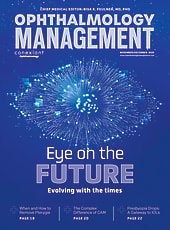For patients over 40, presbyopia remains a challenge, significantly impacting their near vision and quality of life. While over-the-counter, prescription corrective lenses, and surgical interventions have been the mainstays of presbyopia management, presbyopia drops offer a non-invasive alternative.
Currently, the only FDA-approved pharmacologic treatments for presbyopia are Pilocarpine hydrochloride ophthalmic solution 1.25% (Vuity; AbbVie) and Pilocarpine hydrochloride ophthalmic solution 0.4% (Qlosi; Orasis Pharmaceuticals). Both use pupil modulation to create a pinhole effect that increases depth of focus and improves near vision. Clinical trials—GEMINI 1 and 2 (Vuity), and NEAR-1 and NEAR-2 (Qlosi)—demonstrated the safety and efficacy of these drops, showing significant improvements in near vision while preserving distance vision, even in mesopic conditions.1,2
While surgical options (presbyopia-correcting intraocular lenses) remain effective, they can carry risks such as nighttime dysphotopsias. Presbyopia drops provide a non-invasive alternative for patients who are either not candidates for or are uninterested in refractive surgery. Careful patient selection and counseling have yielded positive outcomes in our practice, NVISION Eye Centers.
Our practice first started using generic pilocarpine off-label to manage dysphotopsias in certain patients with corneal higher-order aberrations, but side effects like brow aches made long-term treatment unfeasible. In December 2021, our practice transitioned to Vuity. Over a 3-month follow-up period, many presbyopic patients demonstrated notable improved near vision. No serious adverse events have been observed in our patient cohort.3-5
Preparing the Staff
Patient selection is critical for achieving optimal outcomes with presbyopia drops. Ideal candidates are motivated and committed to consistent use, especially during the initial adjustment period when mild, transient headaches may occur.
In our practice, the best outcomes with Vuity have been observed in patients aged 40 to 50 with early to moderate presbyopia. They typically retain good accommodative reserve and are more likely to achieve functional near vision (J3 or better). These patients often use the drops on an "as-needed" basis. Presbyopia drops can also provide a convenient near-vision "boost" for post-LASIK patients with early-onset presbyopia.
While younger patients see the most pronounced benefits, motivated older individuals with advanced presbyopia can still achieve meaningful improvements with proper use. Successful treatment depends on selecting highly motivated patients willing to commit to the eyedrop regimen.
Vuity is a cholinergic agonist and can cause anterior ciliary process rotation, potentially increasing vitreoretinal traction and the risk of retinal complications. Patients with retinal conditions (lattice degeneration, holes, tears) or other peripheral pathologies should be carefully screened with a dilated fundus exam.
Once the appropriate patient has been identified, providing staff with a prepared script ensures clear communication. For example: “Presbyopia drops improve near vision without glasses or contacts. Consistent use is important and effects typically last 6 to 9 hours. However, they are not a permanent solution and mild side effects, like temporary brow ache, may occur. If you are interested, we can evaluate whether this treatment is suitable for you.”
Staff should also understand the drops' effects, side effects, contraindications, and candidate suitability to address patient questions effectively.
Patient Counseling and Education
Effectively managing presbyopia requires ophthalmologists and staff to educate patients on the condition and treatment options; emphasizing that drops provide a temporary solution and do not “cure” presbyopia. Patients should also understand these drops have not been shown to outperform glasses and their effectiveness varies with age and other factors.
Eyedrop regimen is a crucial component of patient counseling, typically discussed by the ophthalmologist, optometrist, or technician. To stress the importance of adherence, they can address common concerns, demonstrate proper administration, and provide strategies to improve compliance. While the initial FDA approval of Vuity in 2021 to treat presbyopia was for once-daily dosing, in 2023 the FDA approved a twice-daily option.6 The second drop in each eye can be administered 3 to 6 hours after the first, prolonging medication effectiveness from 6 hours (1 drop) to 9 hours (2 drops).6
Another pilocarpine hydrochloride ophthalmic solution 0.4% (Qlosi) was approved by the FDA in 2023 for the treatment of presbyopia.7 While Qlosi has the same mechanism of action as Vuity, it has a lower concentration of the active ingredient. Qlosi can be used twice daily with a maximum effect of 8 hours. The drops may cause temporary dim/dark vision, so patients should be counseled on driving precautions.8
Additionally, contact lens users should remove lenses before use and wait at least 10 minutes before putting them back in.
Informing patients of potential side effects is important for transparency. The most common side effects reported in the trials were headaches and eye irritation. Less common (1-5% of participants) was eye pain, blurred vision and vitreous floaters.
A key advantage of these drops over glasses or surgery is their flexibility—allowing patients to tailor usage to their lifestyle.9 Strategies such as digital reminders, regular staff check-ins, and daily usage logs may enhance patient adherence. Providing educational resources on presbyopia and, if feasible, trial samples can further support patients.
Conclusions and Future Directions
Presbyopia-correcting drops offer a promising, non-invasive solution to age-related vision loss. Careful patient selection, thorough education/counseling, and setting realistic expectations by ophthalmologists and staff help patients maximize their benefits. Follow-up care and consistent communication about presbyopia drops can enhance satisfaction and quality of life for presbyopic patients.
Looking ahead, newer ophthalmic drugs are also in trials or awaiting FDA approval. For example, phentolamine ophthalmic solution 0.75% (Ryzumvi; Viatris Inc.), approved by the FDA in 2023 for reversal of pharmacologically-induced mydriasis, is currently in a phase-3 trial for presbyopia, with data expected in 2025. Unlike pilocarpine, phentolamine acts via alpha-adrenergic blockade, modulating pupil size without directly stimulating the ciliary muscle. This may reduce the risk of headaches and retinal traction.10 In addition, Aceclidine HCl 1.75% (LENZ Therapeutics), which completed phase-3 trials, demonstrated longer-lasting effects, with 61% of participants achieving a 2-line improvement at 10 hours. As a muscarinic agonist, aceclidine induces miosis with minimal ciliary spasm potentially reducing side effects like retinal detachment.
A combination of carbachol 2.75% (cholinergic agent) and brimonidine tartrate 0.1% (alpha-2 agonist) from Visus Therapeutics, currently in phase-3 trials, has shown sustained efficacy with nearly half of participants reading 20/40 at 10 hours. Brimonidine enhances carbachol bioavailability by reducing aqueous humor production and counteracts ocular redness, as low-dose brimonidine is commonly used for eye whitening.11
The future of pharmacological treatments for presbyopia aims to develop formulations that offer longer-lasting effects, reduced dosing frequency, and fewer side effects.12 OP
References
1. Waring GO 4th, Price FW Jr, Wirta D, et al. Safety and efficacy of AGN-190584 in individuals with presbyopia: The GEMINI 1 phase 3 randomized clinical trial. JAMA Ophthalmol. 2022;140(4):363-371. doi:10.1001/jamaophthalmol.2022.0059
2. Holland E, Karpecki P, Fingeret M, et al. Efficacy and safety of CSF-1 (0.4% pilocarpine hydrochloride) in presbyopia: Pooled results of the NEAR phase 3 randomized clinical trials. Clin Ther. 2024;46(2):104-113. doi:10.1016/j.clinthera.2023.12.005. Epub 2024 Jan 11. PMID: 38216351.
3.Eton EA, Zhao PY, Johnson MW, et al. Rhegmatogenous retinal detachment after initiation of pilocarpine hydrochloride ophthalmic solution 1.25% for treatment of presbyopia. Retin Cases Brief Rep. 2024;18(1):98-100. doi:10.1097/ICB.0000000000001309
4. Al-Khersan H, Flynn HW Jr, Townsend JH. Retinal detachments associated with topical pilocarpine use for presbyopia. Am J Ophthalmol. 2022;242:52-55. doi:10.1016/j.ajo.2022.05.011
5. Amarikwa L, Michalak SM, Caul S, et al. Vitreofoveal traction associated with pilocarpine for presbyopia. Ophthalmic Surg Lasers Imaging Retina. 2022;53(7):410-411. doi:10.3928/23258160-20220629-01
6. Hutton D. FDA approves twice-daily dosing option for presbyopia eye drop treatment. Ophthalmology Times. Published March 30, 2023. https://www.ophthalmologytimes.com/view/fda-approves-twice-daily-dosing-option-for-presbyopia-eye-drop-treatment. Accessed Feb. 7, 2025.
7. Hutton D. FDA approves pilocarpine hydrochloride ophthalmic solution for treatment of presbyopia. Ophthalmology Times. Published Oct 18, 2023. https://www.ophthalmologytimes.com/view/fda-approves-pilocarpine-hydrochloride-ophthalmic-solution-for-treatment-of-presbyopia. Accessed Feb. 7, 2025.
8. AbbVie. VUITY - Frequently asked questions. Accessed Feb 7, 2025. https://www.vuity.com/frequently-asked-questions
9. Hutchins B, Huntjens B. Patients' attitudes and beliefs to presbyopia and its correction. J Optom. 2021;14(2):127-132. doi:10.1016/j.optom.2020.02.001
10. Viatris and Ocuphire Pharma. Viatris and Ocuphire Pharma announce FDA approval of Ryzumvl Phentolamine Ophthalmic Solution) 0.75% eye drops for the treatment of pharmacologically-induced mydriasis produced by adrenergic agonists (eg, phenylephrine) or parasympatholytic (eg, tropicamide) agents. News release. Sept. 27, 2023. https://tinyurl.com/498ynbva
11. Hom M, Verhoeven R, Burke J, Schiffman R. Pharmacokinetics and pharmacodynamics of Brimochol. Presented at: the American Academy of Optometry Annual Meeting; 2021. https://tinyurl.com/3kwf2fvm. Accessed Feb. 11, 2025.
12. Katz JA, Karpecki PM, Venable R, et al. Presbyopia: A review of current treatment options and emerging therapies. Clin Ophthalmol. 2021;15:2167-2178. Published 2021 May 24, 2021. doi:10.2147/OPTH.S259011











